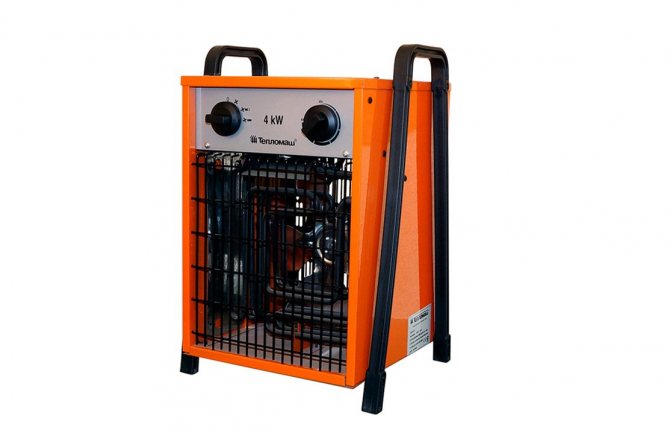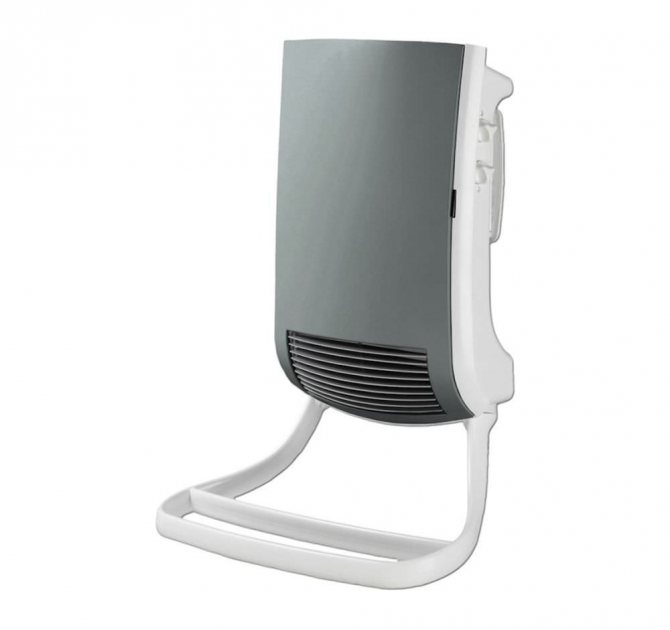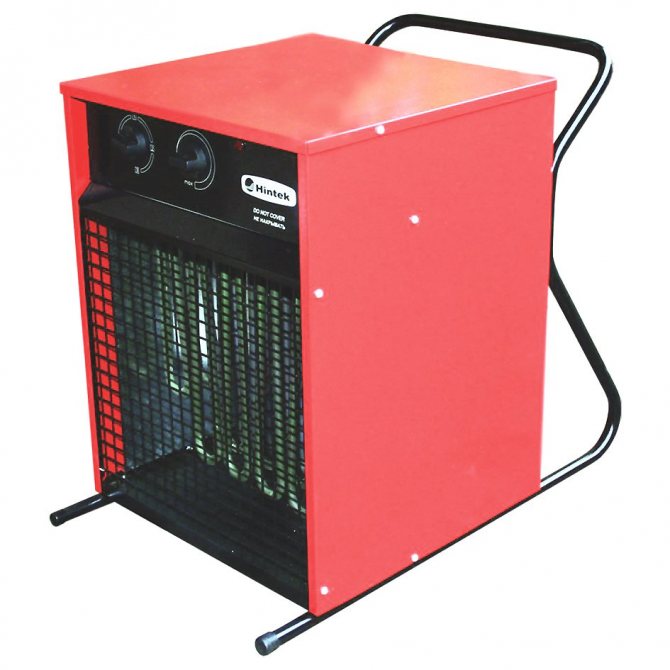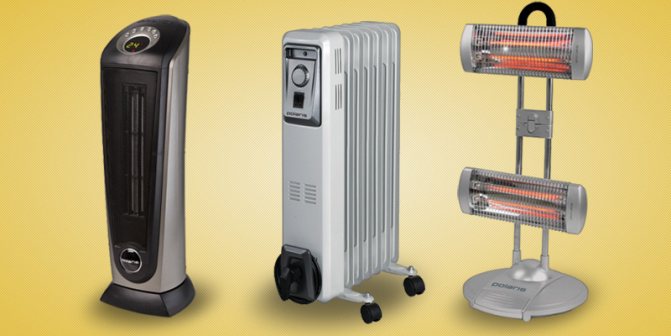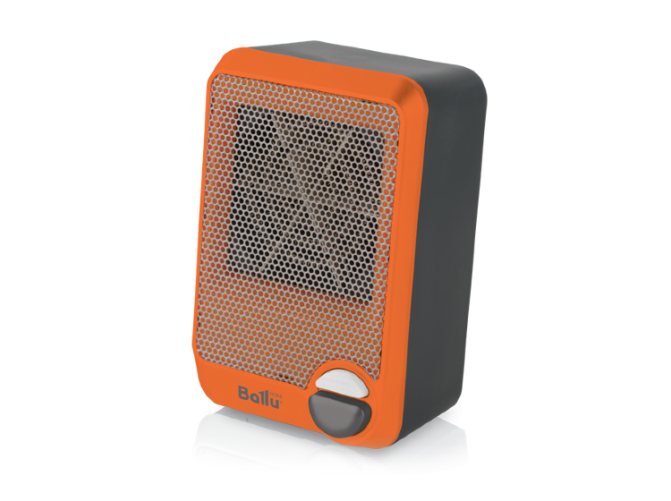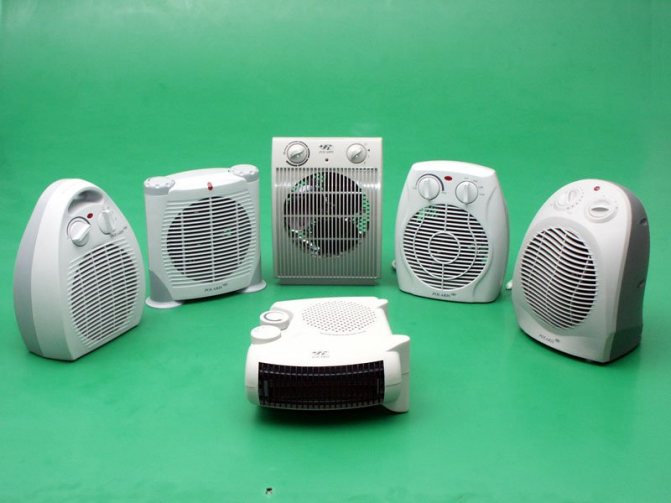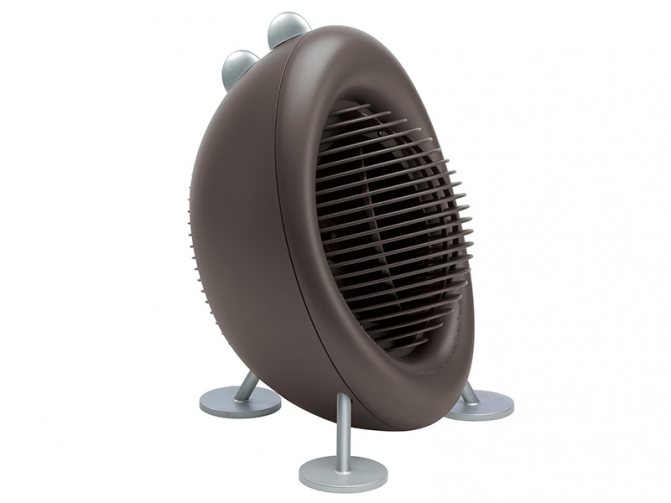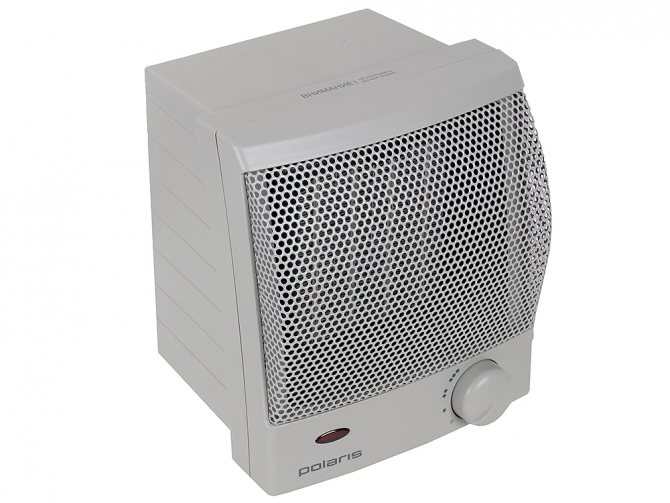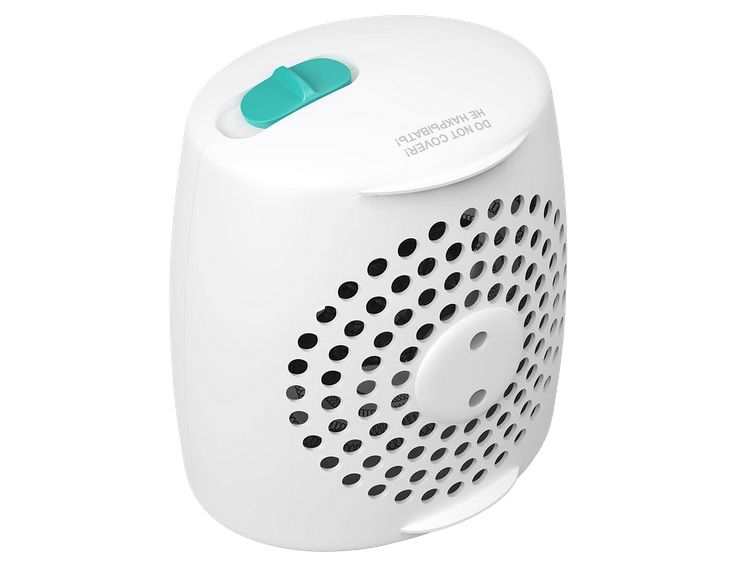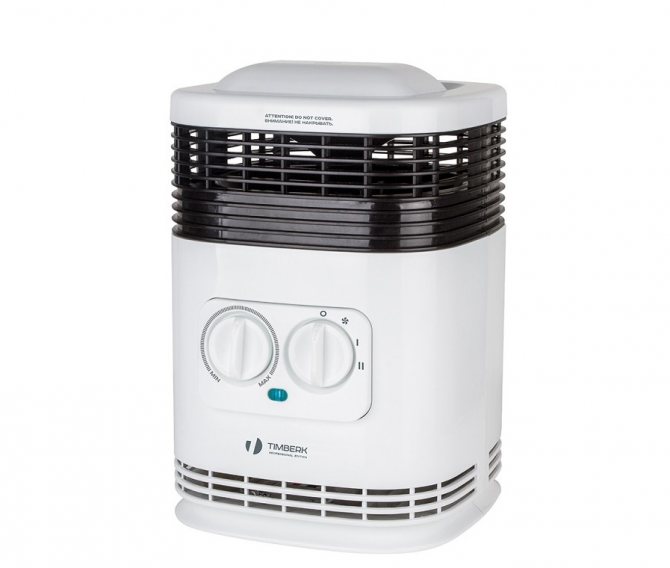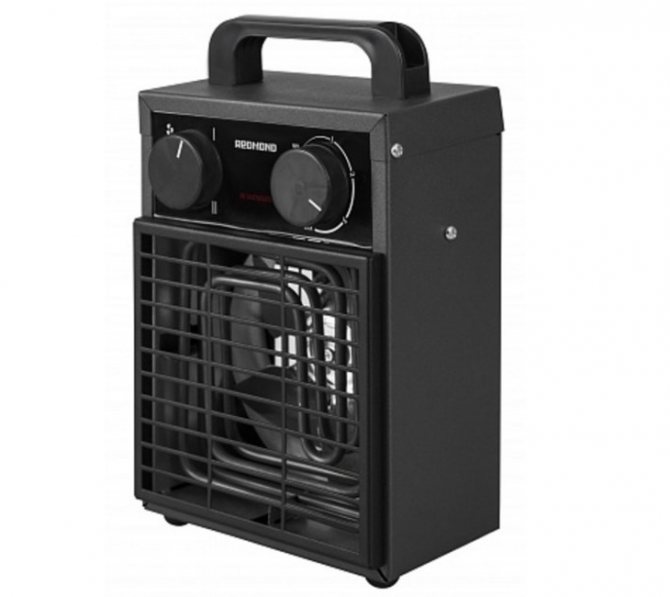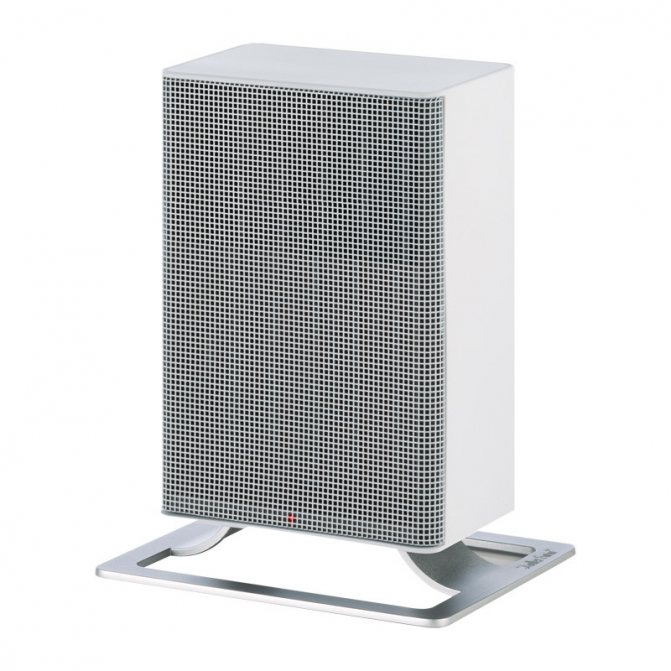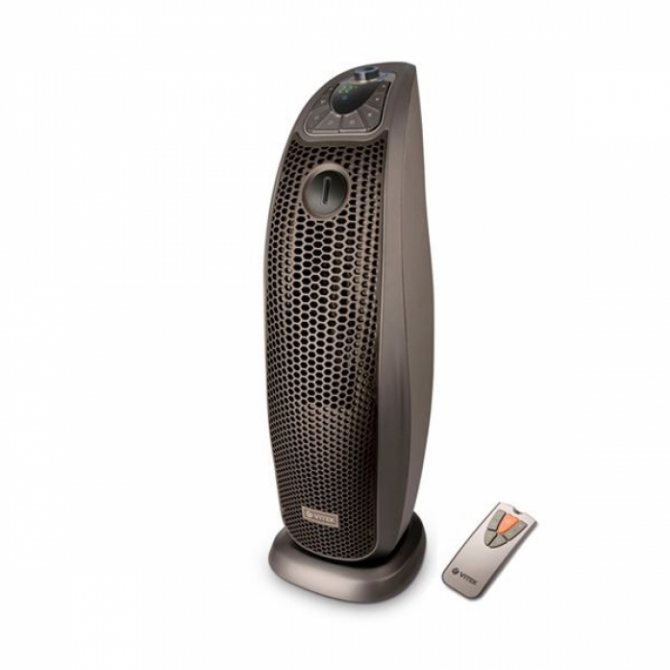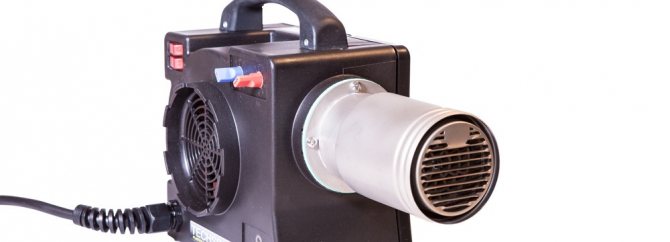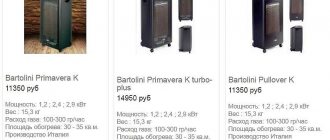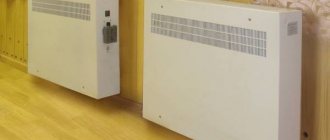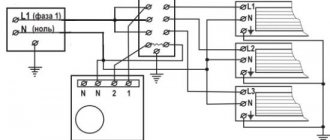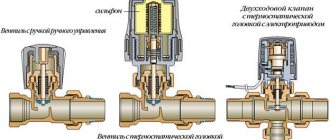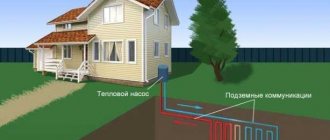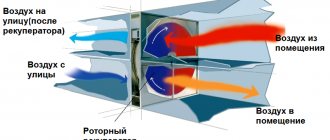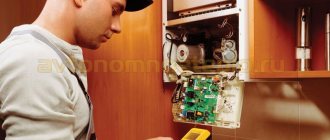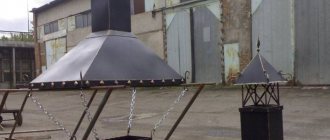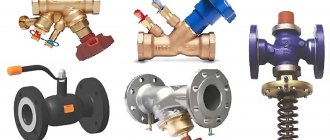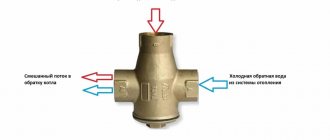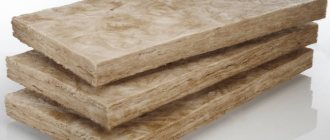How does a fan heater work
Any fan heater consists of three main parts: a housing, a heating element and a fan.
The principle of operation is extremely simple. The fan captures cold air and directs it to the heating element, where it warms up. With the help of the same fan, the air is blown back into the space already warm.
Because of this mechanism, the devices were nicknamed "wind turbines" or "fan heaters".
All of the above elements can have a different structure, the reliability and functionality of the equipment depend on it. So we will talk about each detail in detail.
The main disadvantage of all heating devices is the noise produced, which is explained by the rotation of the blades. In terms of loudness, they are classified as follows (from quietest to noisiest):
- infrared;
- oil and convector;
- fan heaters and heat guns.
So get ready for the monotonous hum. Moreover, the more powerful the unit, the louder it works.
But this minus does not detract from the main advantage - the rapid heating of the room. This happens precisely because of the presence of a fan. It enhances the circulation of air masses, and a comfortable microclimate is achieved in a short time.
How to make a water fan heater with your own hands
The structure can be assembled from a small car radiator, copper pipes and a duct fan. For the body, a galvanized steel sheet with a thickness of 1 mm is selected. A metal box is made of it, in which two working components - a fan and a radiator - are fixed tightly to each other. On both sides, two pipeline circuits are supplied to the system, which can later be connected to the central DHW communications. In the manufacture of a water heater, you will need a jigsaw, a grinder, a marking tool and a set of fittings. You should also calculate that the fan is connected to a 220 V network, otherwise the system will not work. Unless for workshops and large industries, massive ventilators operating under a voltage of 380 V are used.
Device classification
One of the options is the division according to the scope:
- industrial - high-performance installations designed for round-the-clock operation and with improved characteristics;
- household - inexpensive and compact copies used in houses and apartments.
The main feature by which all devices are classified is the installation method. The equipment is divided into two groups: stationary and mobile.
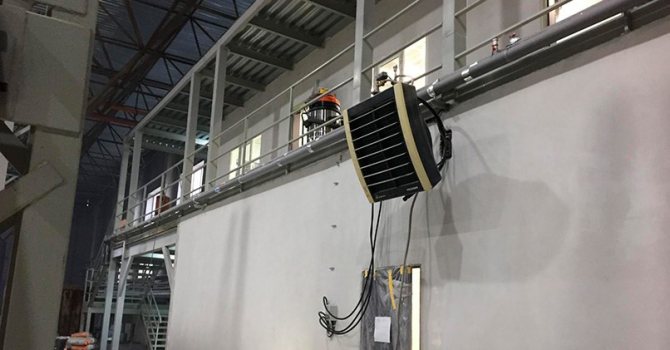
Stationary
This technique requires solid fasteners. It cannot be relocated at a time and often requires site preparation.
But this category of electric heaters, as a rule, is distinguished by increased power and expanded functionality. Therefore, the object can be used even as the only heating device.
Such a system is also safer, since there is no possibility of overturning or getting inside a random object.
As a rule, these samples are equipped with a remote control via a remote control. Otherwise, you will have to climb onto a chair or ladder and manually adjust the settings.
There are two options for fixed mounting.
- Wall
In appearance, they resemble an air conditioner. Some models are equipped with swivel curtains, and then it is possible to direct the stream to where you need it. But most do not flow to the side, but strictly downward.
They are often installed to create a thermal curtain over doors.They heat and do not allow the cold from the street to get inside. This is especially true in organizations with high traffic: shops, hospitals, schools, etc.
- Ceiling
As the name implies, such specimens are attached to the ceiling, which means that efforts will be required during installation. But heaters direct warm masses in all directions and warm even a huge room.
Mobile
Due to their small size and weight, they are easy to move. Also, the device allows you to set the direction of the flow of heat and quickly warm up, for example, a bed. It is the best choice for an apartment in case of heating for a short period.
Among all the variety, there are two groups of devices.
- Floor-standing - have a variety of designs: cubic, in the form of a column, a horizontal cylinder.
- Desktop - differ in the smallest size and weight. There are horizontal and vertical versions.
There are also combined products that are allowed to be placed in different positions. Heat guns are one of the varieties of mobile units.
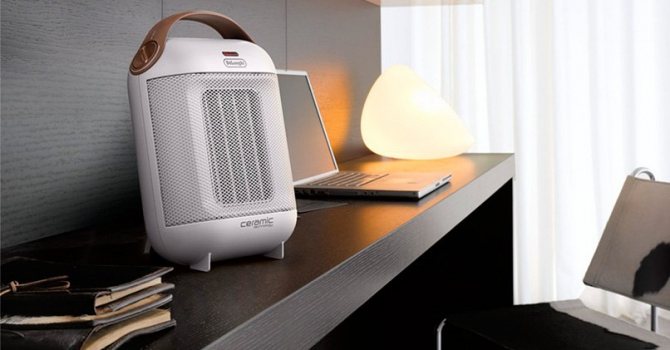

Selecting the required power
In order not to be disappointed in the efficiency of the fan heater after purchase, it is necessary to calculate the required power in advance. It is worth noting that the most common models with indicators up to 2 kilowatts. And this is quite reasonable.
There is a simple relationship between room size and device power. For 1 square meter of the area of the heated room, 100 watts are needed. This means that to create warmth and comfort in a room with a standard ceiling height of about 270 centimeters and an area of up to 20 square meters, a fan heater with a capacity of 2 kilowatts is perfect.
To service large areas, it is worth using heat guns, or high-power tubular fan heaters. However, the formula for calculating the power in this case will remain unchanged.
When purchasing a fan heater, we advise you to take into account that for a truly high-quality and fast heating even in the most severe frosts, it is better to stock up on power. Make a choice in favor of a device whose power will be one and a half times the minimum required value.
Power
The main question to be solved is: what kind of wind turbine is needed. After all, a device with a lower performance will not be able to effectively heat the home. And if you buy a device with high performance, then electricity consumption will increase.
Old aluminum wiring often fails and is flammable. Most of the sockets are designed for a maximum current of 16A: this corresponds to an equipment power of 3.5 kW.
The calculation is considered classic when 10 sq. m of the room requires 1 kW. It is also desirable to add a margin of 10-15%.
Apparatus for a small room or an addition to the heating system, 1-1.5 kW will be quite enough.
To calculate the power for heating only with an electric fan, you need to take into account many parameters - the number of windows, orientation to the cardinal points, the quality of double-glazed windows, climate, etc. It is better to entrust the calculation to a specialist, but you can do it yourself using a special calculator (available on the Internet).
Simplified formula looks like this:
W = S x W beats / 10, where
W is the required power;
S - heated area;
W beats - specific power required for heating 10 sq. m in your climatic zone.
| Climatic zone of Russia | W beats, kW |
| Southern regions | 0,7-0,9 |
| Middle lane | 1-1,2 |
| Northern regions | 1,5-2 |
Types of heating elements of a fan heater
Any of these heating devices is equipped with a heating element. There are three types of them:
- Tubular (ten).
- Spiral.
- Ceramic.
Spiral elements are most often made of nichrome. The main advantage of such devices is their low price.But the combination of high temperatures that are reached during heating (about 1000 degrees) and insufficient or lack of protection makes this device very fire hazardous. In addition to all this, there is also an unpleasant odor that occurs due to the combustion of dust particles.
There is a misconception that nichrome heaters are capable of burning oxygen. Know that it is consumed only by an open flame, and the elements of our equipment work by means of a resistance moving in a spiral of electric current.
Heating element
The central link of the whole mechanism is the heating element. It is he who largely determines the capabilities of a particular model. Even before buying, you will have to figure out which one is better - a spiral or ceramic heater to buy. Or maybe a water heat exchanger is right for you? Therefore, I urge you not to ignore such an important characteristic. There are three main types of parts.
Spiral
It is a thin nichrome wire wound in a spiral on a heat-resistant base. The heating temperature sometimes reaches 1000 degrees.
Such products are cheap and are quite suitable for a summer residence. That's all, this is where the advantages ended, then there are solid shortcomings.
- There is always a fire hazard due to the high temperature. This is possible if a piece of paper gets inside or a large lump of dust flies in.
- An electric current with a voltage of 220 V flows along the curl, which is life-threatening. You can touch the dangerous part through the bars with a thin child's finger or an oblong object.
- Dust and even small insects get inside. They give off unpleasant odors when burned.
- The service life is short.
Such an object should not work around the clock. You should give him a break. You can't leave him unattended yet. Although, having learned about the potential dangers, I think no one would think to be absent for a long time.
Heating element
This is the same spiral, but it is enclosed in a shell. Inside there is a free-flowing substance - quartz sand or manganese oxide. The heating of the flask is half that of the open part: about 500 degrees. In some cases, to improve heat transfer, special plates are installed on the heating element.
This option is characterized by much more pleasant characteristics:
- the problem of fire hazard is being solved;
- the energized link is insulated;
- less smell of burnt dust.
To be fair, I will say that such equipment is produced mainly with solid performance indicators. Therefore, there are few household appliances, an impressive part of goods with heating elements is industrial equipment.
Ceramic heater
The ceramic element is the best choice for the home. It is made in the form of ceramic plates, and the heat exchange grill is made of corrugated aluminum. The design features and materials used give their benefits:
- the device does not heat up above 150 degrees, which means that it is not capable of causing a fire;
- consumes the least amount of electricity;
- lasts longer.
But I think you already guessed that this is an expensive group of devices. Although, due to energy savings, they pay for themselves pretty soon.
Water heat exchanger
Such objects are integrated into the heating system. They help to evenly heat even production halls and offices in a short time. They will not be able to operate during the off-season or when emergency heat supply outages occur.
The power of such heaters is directly related to the water temperature. If it is 80 or 90 degrees, then the maximum effect is achieved.
Views
Before choosing a fan heater, decide where you want to put it. According to the installation method, fan heaters are:
- floor;
- desktop;
- ceiling or wall.
Floor standing from desktop are not much different and can usually stand both there and there.It is convenient when they have a carrying handle at the top, as well as the ability to change the tilt. This way you can direct the flow of heat exactly to the area that needs it most. It makes sense to choose such a fan heater if you will be moving it from room to room or even transporting it to another place (to the country house, for example).
The control of floor and table models of fan heaters can be mechanical or electronic. Mechanical control - a pair of "twists" with graduations, with the help of which the heating mode is set. Their advantage is simplicity and low cost. There is practically nothing to break, so they are reliable.
Electronic control can be implemented in different ways. As a rule, there is a liquid crystal display, which displays all the necessary information. Such fan heaters are often equipped with control panels. There are touch control models.
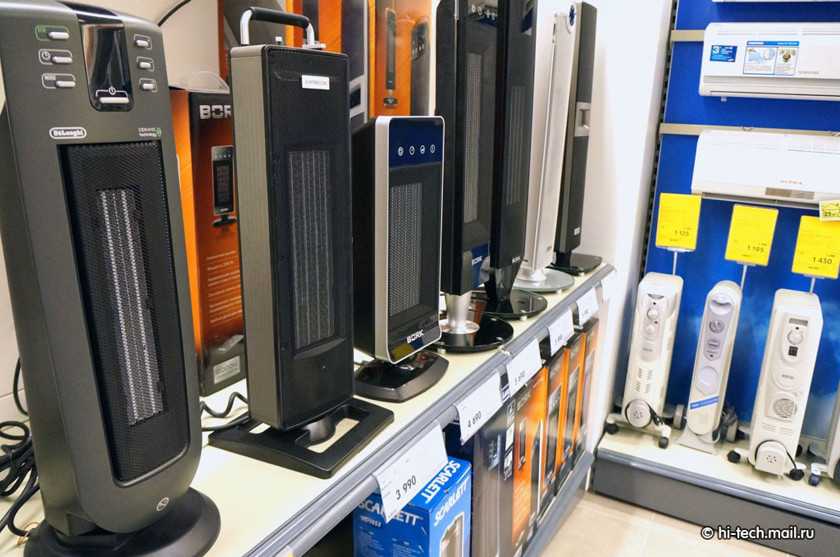

There may be such a design
Ceiling or wall heaters have a different shape - they are long and low, have a higher power, several operating modes. In appearance, they are very similar to the internal block of a split system. It is worth choosing a wall-mounted fan heater if you have a small child. He will definitely not be enough before him.
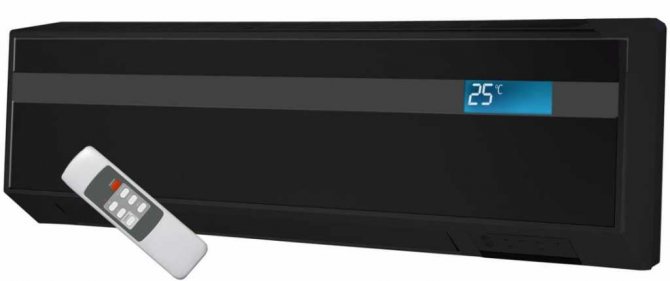

Wall-mounted or ceiling-mounted have a characteristic appearance, resemble the internal block of a split system
A tangential fan is installed in wall-mounted models of fan heaters. It makes less noise, lasts longer. But these models are much more expensive, they have electronic control, controlled from the remote control. It is better if there is a duplicate panel on the case - it will be possible to change the settings manually if the remote control is lost.
Fan
The design of this module determines the service life, the level of noise generated and the need for cleaning.
- Axial
It looks like a propeller in our usual sense. It has 3-8 blades, which are made of plastic or metal. This is a simple and budget mechanism, so it is most often found in household options. Another advantage: the part does not require maintenance and it is enough to occasionally lubricate it with machine oil.
And everything would be fine, but such products are buzzing strongly. Therefore, turning them on at night is not very comfortable.
- Radial
This element is typical for flat horizontal heaters. It looks like a wheel, around the circumference of which there are frequent parallel blades. The air is pumped by centrifugal acceleration.
The blown flow is smoother than that of the axial ones. If the wheel is well balanced and the blades are oiled, then little noise is generated.
- Tangential
It has a cylindrical shape and 20-30 parallel wings. It is the most productive and quietest, but due to design features it is not used in all devices. Among floor models, this type is not found in columns. But in wall and ceiling copies, an accessory of this type is not uncommon. The only upset is the need for regular cleaning.
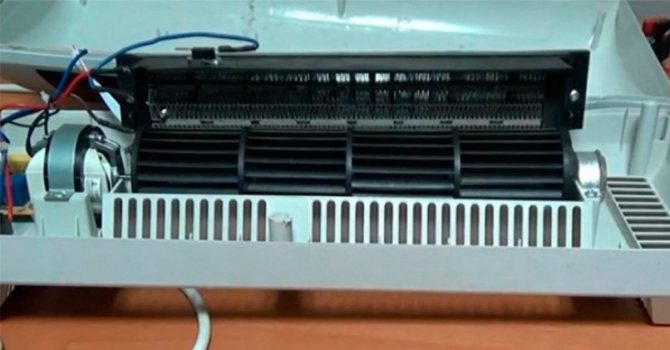

Types of fan heaters
In any home appliance store, fan heaters are presented in a wide range of models. In order not to "get lost" in all this variety, it is worth keeping in mind that devices are divided into three main types:
- Ceramic
- Spiral
- Tubular
Models with ceramic plates installed as a heating element are considered the most expensive. However, the indisputable advantages are their safety and durability. Manufacturers say with confidence that dust and small debris that can settle on the heating plates will never catch fire during operation. The energy efficiency class of this type of device is much higher than that of the others.Despite the fact that the maximum heating temperature is only 150 degrees, during the operation of such a fan heater, the air heats up very quickly, due to the large area of the heating element.
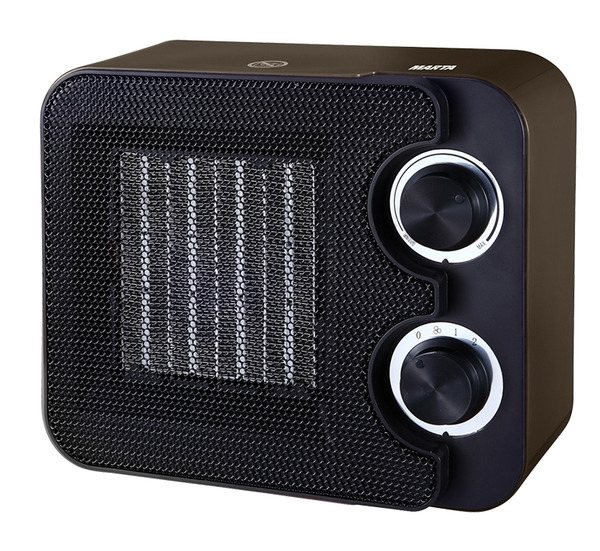

When buying a ceramic fan heater, please note that the material from which the plates should be made is glass ceramics, often found sintered devices do not have the desired advantages.
Devices equipped with a nichrome spiral, in turn, are considered the most fire hazardous. During operation of this fan heater, the coil heats up to 1000 degrees, as a result of which careless handling can lead to fire. It will also not be possible to avoid an unpleasant odor, because the dust caught on the spiral will burn. Such models fail faster than others, although they are sold at very attractive prices. This advantage often plays a decisive role if there is no need for constant use of the device.
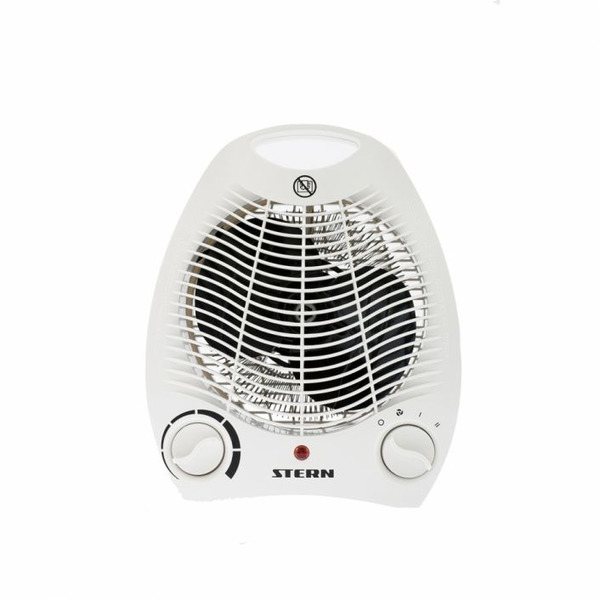

If your choice fell on a fan heater with a spiral type heating element, purchase a model with overheating protection. This function will greatly increase the service life and operational safety.
Fan heaters with a tubular heating element are unlikely to be used in a residential area, due to their high power. It is advisable to install such a unit in a garage or in a production facility. Teng is directly a metal tube filled with quartz sand doped with manganese oxide and including a nichrome wire rod. The highest heating temperature of such a tube is 500 degrees, and the heating is uniform, which increases the service life. The price of a tubular fan heater is very high, however, it cannot be replaced as a heat gun.
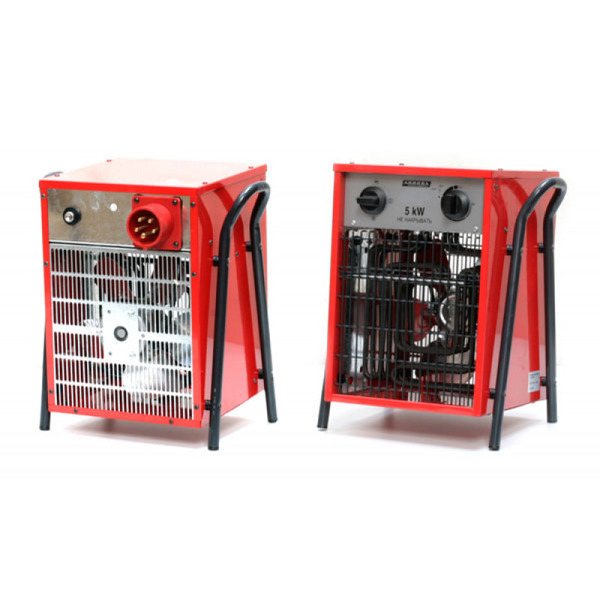

Having decided on the type of heating element, it is necessary to decide whether the device will be installed permanently or there is a need for its mobility.
In the first case, the fan heater can be installed on the floor or mounted on the wall or even on the ceiling. Such models are equipped with a cone-shaped fan with a couple of dozen blades located perpendicular to the axis of rotation. Due to this feature, productivity is significantly increased.
The advantage of wall-mounted units is that they save space. The design of these models is such that it allows directing a stream of warm air in the required direction. Due to this feature, they are often used as a thermal curtain, installed above the front door.
For uniform heating of rooms with high ceilings, ceiling fan heaters are useful.
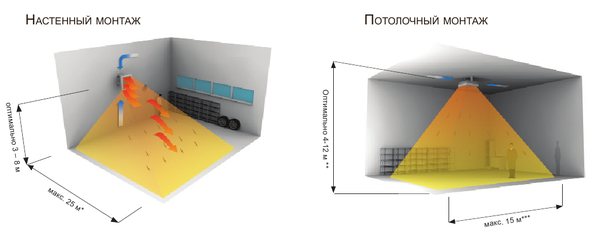

Floor standing appliances are usually pillar-like and often have a rotating base that distributes warm air in all directions from the fan.
Almost all stationary models can be used not only for generating heat, but also as a fan during the hot season.
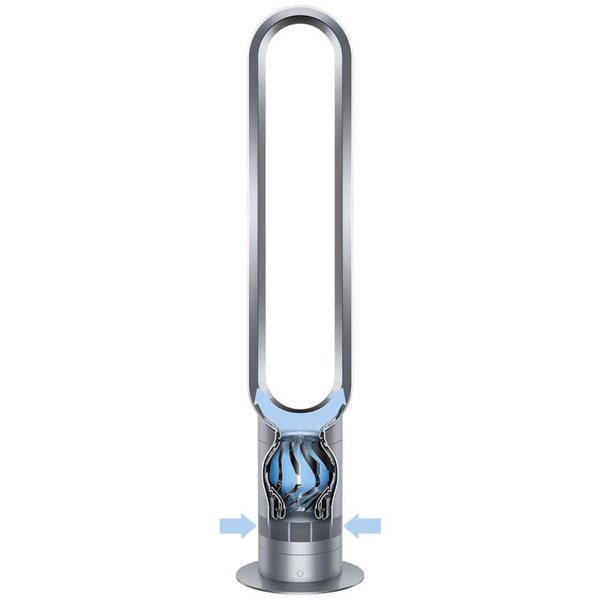

If there are often children in the room where the fan heater is installed, it is worth giving preference to models with a wall mounting method. This will help keep your child out of direct contact with the electrical appliance.
Wearable devices also have a number of advantages. They are compact, lightweight, easy to install and transport. It is worth noting that these fan heaters are very budgetary in comparison with stationary models. Such a unit can be safely installed to heat a small room, at the workplace, and even be used to heat greenhouses in the spring-autumn period.
However, due to the design features, namely the use of an axial type of fan, the operation of such an electrical appliance is always accompanied by unpleasant noise.
Body material
The body is made of plastic or metal. The first products are found much more often than the second.
Plastic devices are cheaper and much lighter than metal ones, but you need to pay attention to their quality. Cheap ones when exposed to high temperatures can melt and release harmful substances.
The metal sheath is most often found in expensive industrial facilities, where the heating is significant. Plastic will simply not be able to withstand such treatment.
It is good if the body, regardless of the material, is splash-proof. Then the fan heater is allowed to be safely installed in the kitchen or bathroom.
Device
A water-based industrial heat blower is a device that generates heat from hot water, which is supplied by a fan. The equipment does not require connection to a gas dispenser, boiler or other source of energy. In another way, such a device is also called - a heater. Unlike heating radiators, the air heater heats the room faster due to the air jet expelled from the device for exchanging contrast-temperature media by an electric fan.
Its device has the following components:
- body made of heat-resistant material (plastic, metal);
- heat exchanger - an internal device that allows the exchange of multi-temperature media in order to heat the air;
- fan with an electric motor;
- louvred grille - protects the structure from the outside and delivers a directional flow by adjusting the plates;
- temperature controllers;
- speed regulators;
- thermostat;
- conductive part - pipes;
- connecting part (fasteners, power cord);
- insulating material to protect against dust and moisture.
The principle of operation of the device:
- The heat carrier is hot water, taken from a hot water supply system, or from a central heating system and supplied through pipes to the compartment, where different temperatures are exchanged.
- The pipes are heated, thereby heating the air in the compartment.
- The fan expels the heated air.
- Swivel louvers direct the flow in the right direction.
The grille in some models can be stationary, without turning mechanisms. This means that the direction of the heat air flow will be in one direction only. The pushing force is created by the fan power - the more powerful this device, the farther the jet will reach the space. The supply temperature can be different - from a warm stream to a hot stream.
For the correct use of the fan heater, special installation of the structure is required. The installation is not portable, therefore it is required to attach it to the wall (less often to the ceiling). In addition, connection to the coolant is also carried out, which means the placement of pre-provided communications - pipes coming from heating radiators or from the water supply network.
Control and functions
The simplest models are equipped with mechanical switches. To adjust, you only need to turn the knob. This is very convenient for those who are not friendly with modern technologies. For example, for the elderly.
More advanced designs are equipped with buttons or sensors with a display. Here, as a rule, the remote control is supplied.
Let's name the most popular options:
- power regulator - there is even the cheapest copies and is needed to adjust the intensity of the blowing;
- thermostat - a device with automatic temperature maintenance at a user-selected level;
- timer - allows you to program the on and off times;
- rollover sensor - useful for ensuring the safety of floor and table products;
- overheating protection - turns off the equipment if the temperature of internal components has reached a critical level;
- frost protection - automatic heating of the device up to +5 degrees Celsius prevents the unit from failing due to frost.
A dear helper is able to take on the “duties” of another technique:
- fan - a wind blower drives air masses without heating them;
- humidifier - corrects dry air caused by heating;
- air purifier and ionizer - the space is filled with useful negative ions and is cleaned thanks to the filter system.
Advantages and disadvantages
Fan heaters are of little use for constant heating - due to the high power consumption, the heating fee is too high. In addition, the fans generate noise. The more expensive models are almost silent, while the cheaper ones can "sing" loudly enough. During the day, you can still transfer the noise accompaniment, and then it gets on your nerves. At night it is generally unpleasant. To choose the right fan heater, pay attention to the noise level (indicated in the technical specifications). You will not perceive it as something annoying if the noise level is up to 40-45 dB. Anything higher is already loud.
These are common "troubles". There are also disadvantages inherent in fan heaters with spiral heaters:
- low reliability - burn out quickly;
- for very cheap Chinese models, after the first few turns on, there may be a smell of burnt plastic;
- an unpleasant smell will be constantly felt due to combustible dust;
- cheap models have no overheating protection.
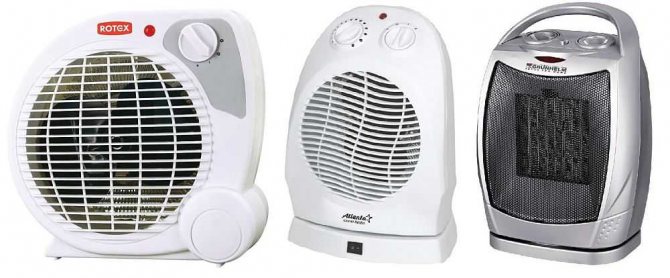

They can be very different in shape and power.
It's all about the disadvantages. We talk so much about them so that you understand what to expect from this technique. But she also has pluses. The advantages of fan heaters are as follows:
- They are good if you need to quickly warm up a small volume of air.
- They have a low cost (even the purchase of expensive models does not really hit the pocket).
- Simple device - inexpensive repair. Although, few people repair them - it's easier to buy a new one.
As you understand, this is not the best heating equipment. But choosing a fan heater for a house, a summer residence, an apartment is worth it for the following cases:
- Create a small comfortable area in an office or apartment when the heating has not yet been turned on.
- For work in the garage during the cold season (although heat guns or infrared fuel or gas heaters are more efficient).
- Warm up the shower room, toilet outside before visiting. Even in spring and autumn, going to an outdoor toilet is not a very pleasant activity precisely because of the cold. By placing two fan heaters on the sides, you can bring the temperature to quite comfortable in a matter of minutes. If you turn on the switch at the exit from the house, until you reach the room, it will no longer be cold.
- Heat up a cold room quickly. For example, fan heaters are placed in the country, when visiting in spring or autumn. But they turn on only until the stove melts - so as not to sit in the cold. Due to the property of the fan heater to dry the air, condensation will not form.
- Dry your shoes or clothes. A stream of warm air directed at things dries quickly. Sometimes this is used in the country, in the garage.
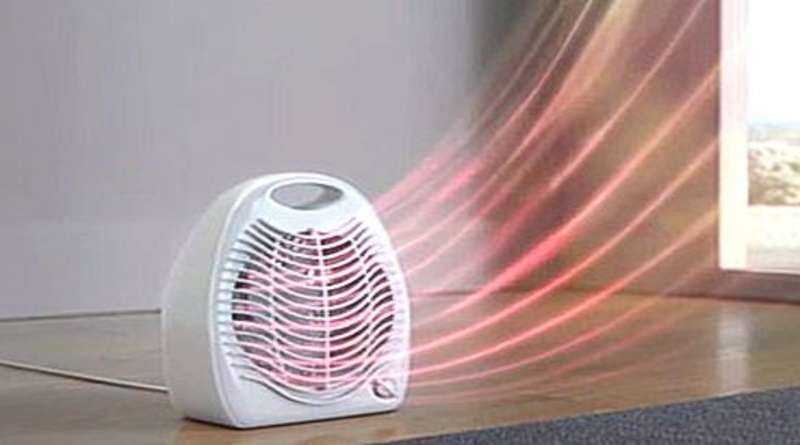

The main advantage is that heat spreads quickly
In general, a fan heater is a good choice if you need to quickly warm up a small volume and you need to do this for a short time. Otherwise, the costs will be too high, and the noise will interfere.
TOP-5 fan heaters
Determining the choice among all the variety is not easy. I hope this list of popular models will help you.
Ballu BFH / S-04 is the simplest unit for 750 rubles. A spiral is used here as a heater, and the fan has an axial structure. The increased power - 2000 W - allows it to be used in rooms up to 25 sq. m. There is one more mode - 1000 watts. Equipped with a thermostat to control overheating.
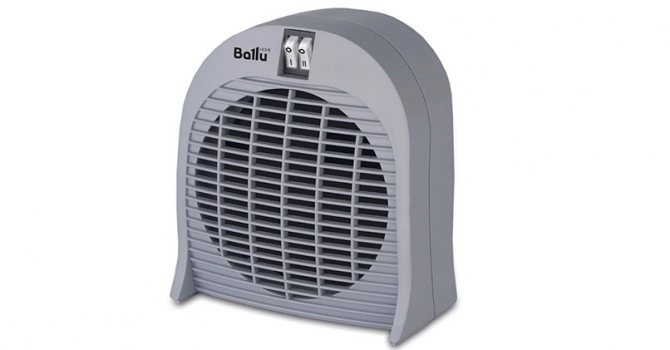

Pros:
- inexpensive;
- compact;
- coverage of a large area;
- warranty - 2 years.
Minuses:
- only two modes;
- short cord.
Electrolux EFH / C-5115 - desktop copy for 2,200 rubles. It is characterized by a power of 1500 watts. The special configuration ensures fast heat distribution. Appliances are equipped with modern ceramic elements.The choice between three possible settings is made by two rotary switches. This is a unit with a thermostat and an overheating sensor that turns off the device if necessary.
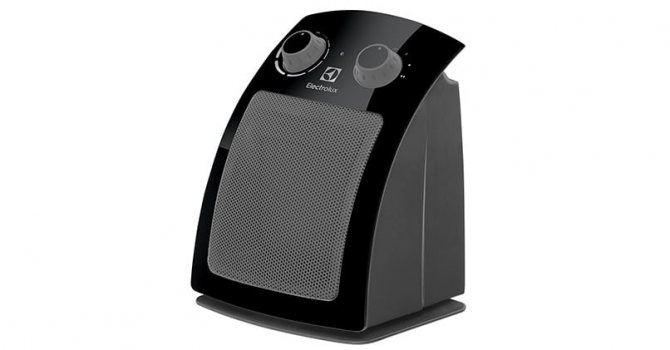

Pros:
- copes with space up to 20 sq. m;
- modern design;
- environmentally friendly and high quality materials;
- the case does not heat up.
Minuses:
- quite noisy;
- wire only 1 m long;
- low sensitivity thermostat.
Tefal Intense Comfort Hot SE9420F0 is a floor-standing column-shaped device for 11,000 rubles. The power of the ceramic heater is 2,400 W. Has a wide blowing angle - 90 degrees. Three modes are built in, including ventilation without heating, shutdown is provided for overturning and overheating. There is a thermostat, timer and delayed start, which allows you to program the operation up to 24 hours. I would especially like to note the ECO function, due to which electricity consumption is reduced by 50%.
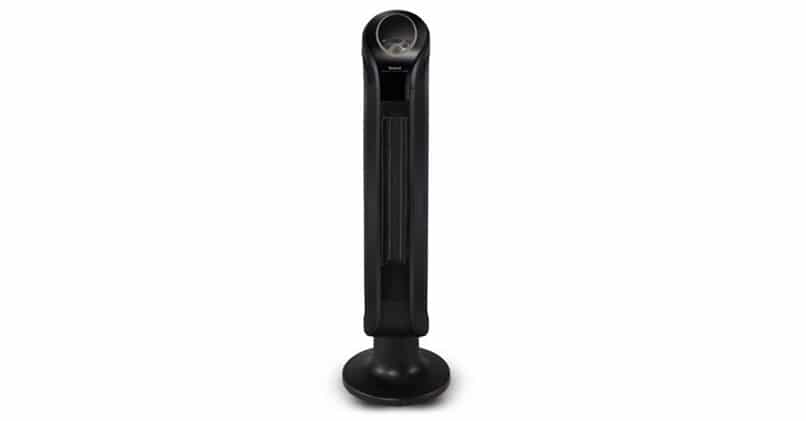

Pros:
- quiet;
- economical;
- long cord;
- there is a remote control.
Minuses:
- sound accompaniment of pressing buttons interferes at night;
- fingerprints are visible on the side panels.
Stiebel Eltron CK 20 Trend LCD is an elegant wall sample worth 14,500 rubles. The rectangular shape and white plastic with gray accents create a laconic design that will fit into any interior. Power - 2,000 watts. A wide range is available from +5 to +30 degrees. It has overheat shutdown functions, a weekly timer, and anti-freeze functions. Adjustment is carried out using sensors and a display.
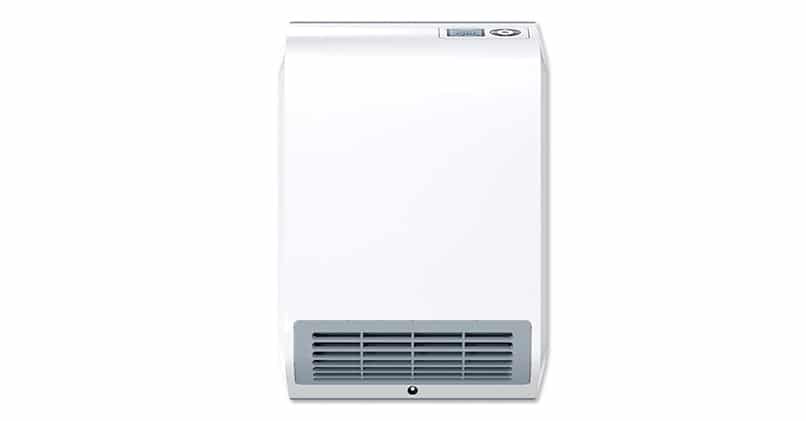

Pros:
- compact and lightweight;
- low noise level;
- there is a compartment for the cord.
Minuses:
- periodic cleaning of the air filter is required;
- no remote control.
Teplomash KEV-25T3W2 - industrial water heater for 18,500 rubles. Its power at a coolant temperature of 80 degrees is 8.3 kW, and at 90 degrees - 11.9 kW. He pushes warm air at a distance of 8 m from him. The included swivel bracket makes it possible to install the device on a wall or ceiling.
The set includes two control panels: a wired one (you will have to fix it next to the device) and a remote one. The casing is made of powder coated galvanized steel.
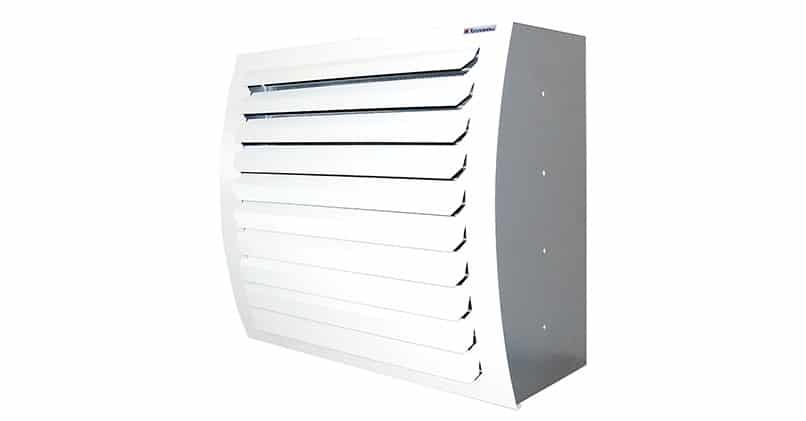

Pros:
- all the necessary fasteners included;
- energy efficiency;
- protection class against dirt and moisture IP44;
- adjustable lamellas.
Minuses:
- loud;
- complexity of installation.
Additional functions
Most of the useful or necessary options have already been voiced, but there are several that may also be useful:
- On indicator. Although the fan heater is noisy during operation, the presence of an indicator allows you to find out from a distance whether it is on or not.
- Cold mode. Allows the device to be used as a fan.
- Rotary models. Some models can rotate a certain number of degrees. This allows the heat to be distributed more evenly.
- Louvers for changing the direction of the air flow. It is a cheaper alternative to swivel models. Blinds can be on floor / table and ceiling modifications, in the latter case they are controlled from the remote control.

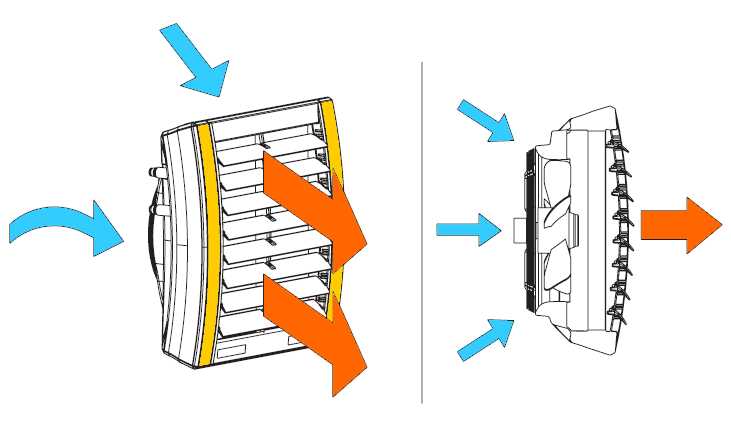
Rotary louvers can be used to change the direction of the warm air flow
- Delayed start. You can program the device to turn on before your arrival.
- Dust filter. Installed in front of the fan. Cleans the air from particles suspended in the air.
- Frost protection. Thermo fans may not work after exposure to frost. Devices with frost protection tolerate lower temperatures normally.
In the struggle for the buyer, manufacturers are trying to come up with and implement new options. If you prefer to choose a fan heater "for a long time" and like comfort, some of the options described above will be very useful.
Best Online Stores To Buy
A heater is a rather dangerous household device. Buying a fake is fraught with not just wasted money, but a real threat to health and property.So take the equipment only in trusted stores:
- MirCli - industrial and household equipment for sale;
- Eldorado - a large selection of devices of different configurations;
- Holodilnik - 57 devices of all types;
- AllTools - goods of 36 brands;
- DeLonghi - official representative of the manufacturer;
- Citylink - 35 variants of fan heaters are on sale;
Design features
The main structural components of this electrical device are a heating element and a fan, designed to distribute warm air throughout the room. In some models, several heating elements of the same type are installed to increase power.
Types of heating elements in fan heaters:
- Nichrome spirals. Devices with nichrome spirals are the cheapest. They effectively heat the air, but they have a significant drawback - combustion products are released into the room.
- Ceramic plates. These heating elements are considered the safest. They are less productive than nichrome spirals. Their advantage is the absence of harmful emissions into the air.
- TEN - tubular electric heater. The heater is built into a metal tube. The heating elements are characterized by high performance, therefore they are used for heating large-sized areas.
Fan heater control can be mechanical (using buttons and switches) and electronic. In the second case, the parameters of the device are displayed on the display. The electrical circuit of modern fan heaters may include:
- Motion Sensor. With the help of this device, the device determines where people are in the room and turns the body in that direction.
- Swing mechanism. The fan heater evenly heats the area when rotating.
- Controllers. With their help, commands are set and functions are switched. These devices may be included as standard or must be purchased separately.
Devices with humidifiers allow maintaining a normal level of humidity in the room, which drops during the operation of the heating elements. To increase the distance over which a warm stream of air is transmitted, a special confuser can be purchased in the store.
Which fan heater is better to buy
Fan heaters suggest several types of installation: stationary with mounting on the wall or ceiling, and mobile - portable compact unit. If the room is spacious and does not have a main source of heat, then it is better to stay with a stationary device. But mini heaters are suitable for temporary heating of a room during cold snaps.
Also, it is important to pay attention to:
- Heating element type;
- Power;
- Control (mechanical or electronic);
- Appearance and dimensions.
Most of the fan heaters are manufactured with a ceramic element. Its advantage is safety of use. The heating wire is coated with a thick glass-ceramic layer and prevents dust or debris from igniting. The heating element is in second place. It is also safe and does not cause a specific odor when turned on. But you need to be more careful with spirals, the wire is bare and heats up to 800 degrees, burning dust and objects that have fallen through the grate.
The power of the device is responsible for the temperature and heating rate - the higher it is, the faster the device will heat the room. The norm for home models is 1000-2000 W, industrial ones are more powerful - they consume over 3000 W and need a separate line.
Recommendations: Top 10 Oil Heaters
How to choose a fan heater for a house, apartment, cottage and garage
Heat fan selection rules
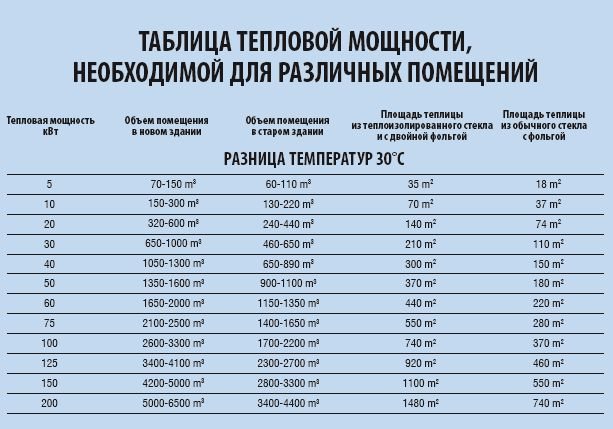

The purchase of a heater depends on the temperature requirements, the regularity of being in the room. It is best to choose a fan heater taking into account the technical characteristics and cost of the device.
When determining the type of unit, pay attention to the indicators:
- power consumption;
- type of thermoelement;
- number of additional functions;
- functionality mode.
Low power home devices are selected. Industrial units are designed to heat large rooms. The technical data sheet indicates the characteristics with the help of which the optimal model is selected without overpaying for unnecessary functions.
Power
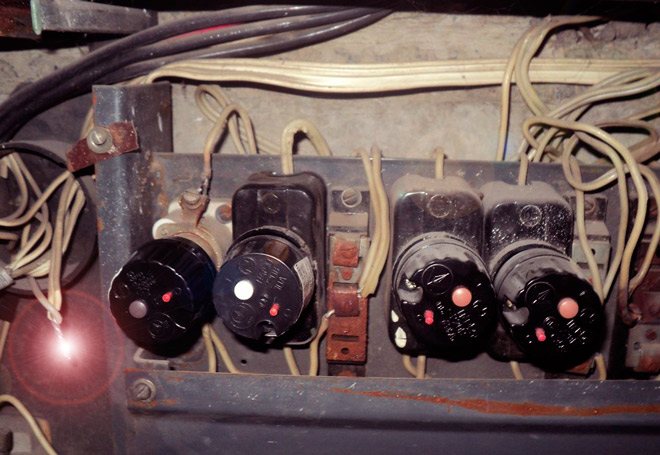

In houses with old wiring, you cannot turn on powerful appliances.
Home fan heaters are characterized by a capacity of 0.8 - 3.0 kW and are used for rooms with an area of 10 - 20 m2. If the device complements the main water heating, it is enough to select an indicator of 1 - 1.5 kW.
Low-power devices (0.8 - 1.2 kW) are used in such cases:
- the building has old wiring with aluminum wires and an overload of the electrical system threatens with fire;
- the house has several rooms and appliances must be turned on in each;
- small size of the room.
Ordinary household sockets have a current limit of 16 A, which corresponds to a power of 3.0 kW, therefore, it is not recommended to use powerful fan heaters for a long time.
Heating element
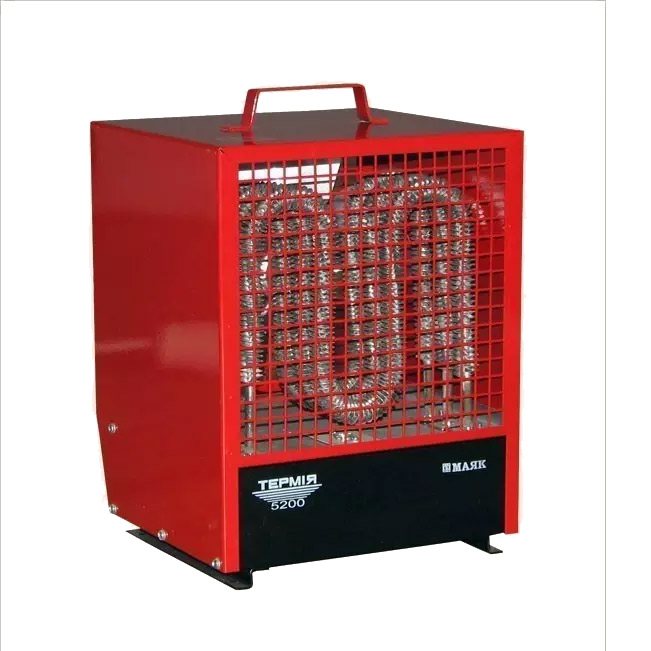

Spiral fan heater
Nichrome wire has been used in devices for a long time and is a cheap type of heater, reaching + 800 ° C. The spiral often burns out, is a fire hazard, therefore the device requires a monitoring overheating sensor.
The heating element burns out less often, since it heats up to + 450 ° С, the dust in the air does not burn out, so there is no unpleasant smell. The price of heat fans with heating elements is higher than spiral fans, but they are safer. In ceramic units, the heater is made of semiconductors covered with a protective layer. The temperature is in the range of +100 - + 150 ° С, and the impeller is located behind the element, which provides uniform cooling.
Modes of operation
Each model has several modes of functionality. Some are exhibited during the off-season to create comfort, while others are ideal on frosty days.
Varieties of modes:
- ½ power indicator is indicated on the panel by one dot or number 1;
- work in full force is selected by moving the toggle switch to 2 points or number 2;
- ventilation is carried out when the handle is moved to the initial position.
The third position is chosen in the summer when airing the room. Switching the toggle switch means changing the speed of the impeller revolutions, coordinating heating, automatically maintaining the selected indicators.
Additional functions
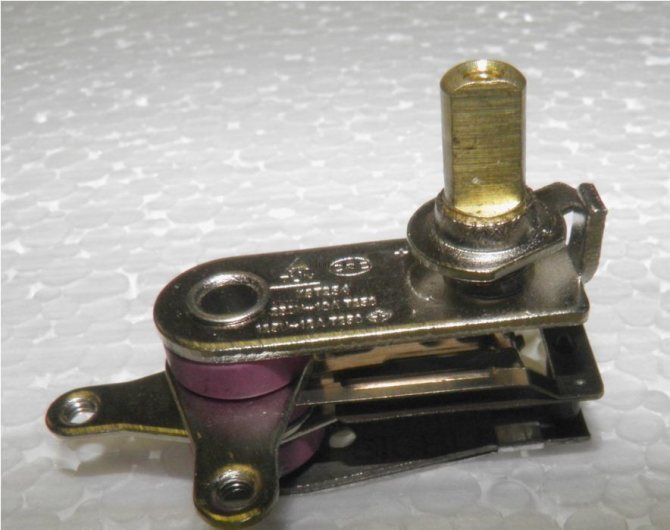

Fan heater thermostat prevents equipment overheating
Overheating protection is implemented by a thermostat and turns on when the maximum values are reached, the fan heater stops working for a certain time and cools down. There is a relay that turns off the device when dropped or thrown over.
The air flow rate is regulated by the selection of the fan speed. The mode is selected if the area close to the heater is heated without heat spreading throughout the room.
Additional features include:
- device rotation mechanism;
- silent bearings;
- thermostat;
- case with protection against moisture drops;
- humidifying device;
- air filter;
- remote command set.
The ionization function is available in additional working conditions, but for efficiency it is better to purchase a separate device.
The best wall heaters
Electrolux EFH / W-1020
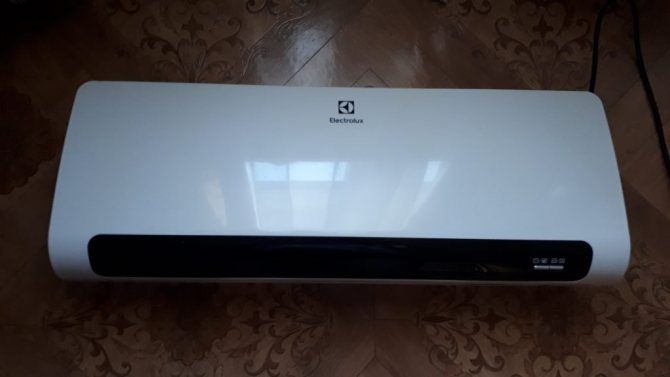

A fan heater for wall mounting looks like a miniature air conditioner. The body of the device is plastic, it is equipped with a convenient display and a thermostat that protects against overheating. The device operates in two heating power modes - 1.1 and 2.2 kW.
The air heats up almost instantly. The filter removes dust from the air and disinfects it. The device is designed for indoor use up to 27 m2. All materials used in the manufacture of the device are environmentally friendly.
Advantages:
- rapid heating of air;
- remote control;
- the presence of an ionizer for air;
- minimum noise;
- beautiful appearance.
Minuses:
- temperature sensor with a large error;
- short power cable.
Timberk TFH W200.XS
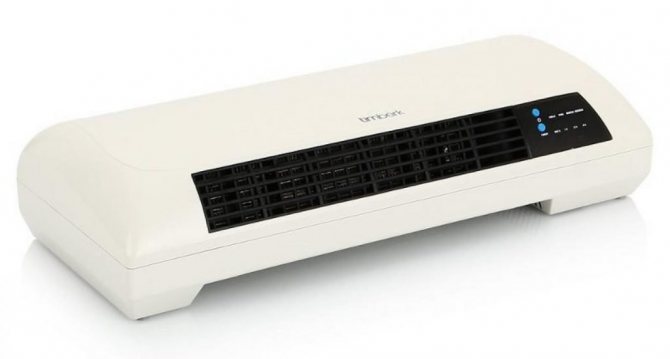

Nice modern design and ergonomic body are the main distinguishing features of this model. On the front side there is a control panel with LED indicators. Thanks to the timer, you can delay the switching on or off of the device (time shift up to 7.5 hours).
All the functionality of the device is duplicated on a compact, convenient remote control. The heater at the convector is ceramic. The fuse and thermal limiter make the use of the heater completely safe. There are 2 heating modes in terms of power: 2.0 and 1.0 kW. The cold air blowing function allows you to use the device in the summer to ventilate the room.
Positive reviews:
- low cost;
- good heating of the room;
- the presence of a timer;
- high-quality assembly;
- control from the remote control.
Of the minuses, only one was named: the lack of regulation of the direction of the air flow. Some customers notice a distinctive "plastic" smell in the first few days of use.
Polaris PCWH 2063Di
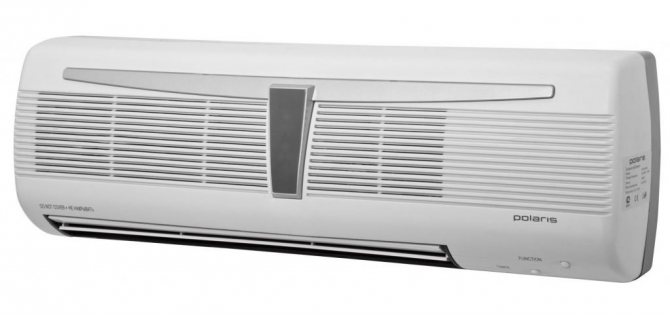

A heater from Polaris will create a comfortable temperature regime in the room without overdrying the air. The built-in ionizer will purify the air, and reliable protection against overheating will prevent sudden damage to the device. Technical features of the model:
- 2 heating modes: 1 and 2 kW;
- ventilation mode;
- the possibility of adjusting the direction of the air flow.
Benefits:
- efficient heating of the room;
- reasonable price;
- remote control;
- the device takes up a minimum of space due to wall placement;
- there is an air ionizer.
There are also disadvantages:
- noisy work;
- plastic over time acquires a yellowish tint;
- insufficiently responsive remote control.
The best outdoor fan heaters
Dyson AM09 Fan Heater
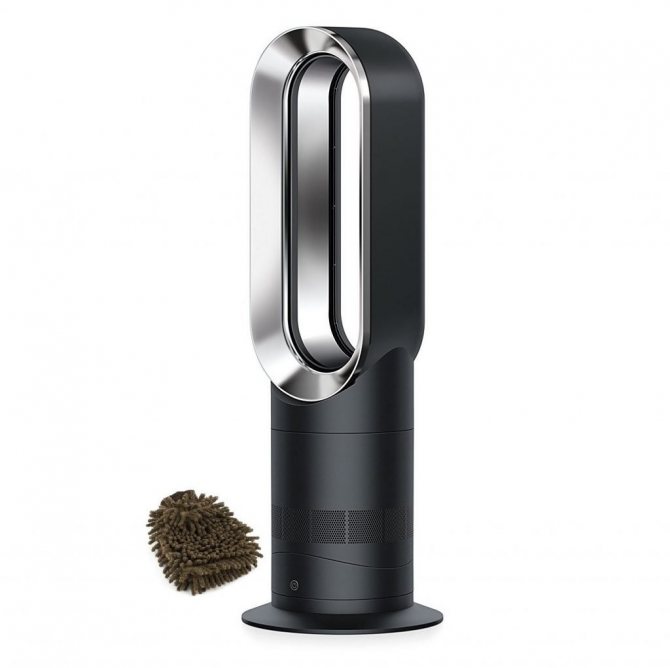

A unique model that can be used in 2 modes: to create directional or diffused airflow. In the cold season and off-season, the device allows you to maintain comfortable warmth in the room, and in the summer heat, the fan provides air cooling. The design feature is that no blades are provided in it. This makes the device completely safe to use. Heating power 2000 W, ventilation - 30 W.
Pros:
- beautiful appearance;
- branded quality from a well-known brand;
- fast heating of the room;
- control from a remote control or a mobile device;
- ease of movement;
- safety.
Disadvantages:
- high price;
- loud noise during operation.
BORK O703
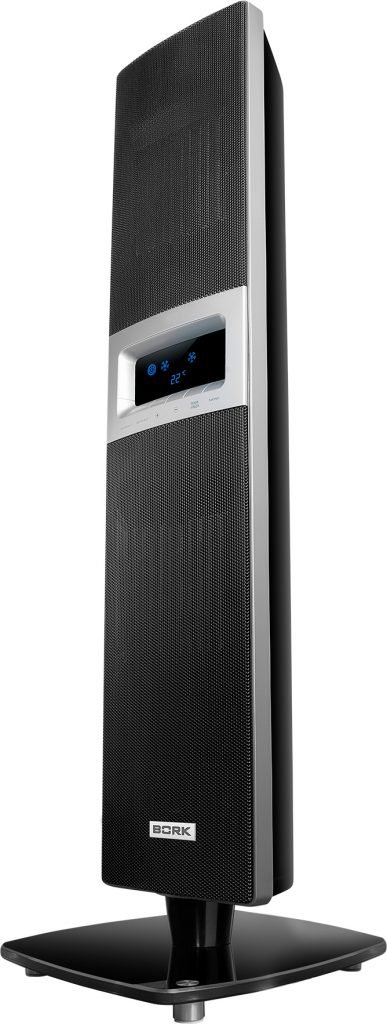

A unique heating system for the home, equipped with two independent heating elements. This allows you to heat the desired area without unnecessary energy consumption. The device allows you to set the air temperature within 15-35 degrees.
An accurate climate control system maintains the preset mode. The power is 2.5 kW. The fan heater heats the air without burning oxygen. The body is designed to rotate 76 degrees, which contributes to an even distribution of heated air masses. Timer, touch control and air temperature indicator make the fan heater control extremely comfortable.
Benefits:
- efficient heating of the room;
- small size and weight;
- climate control function (the air in the room does not dry out);
- the possibility of using only the top or bottom fan.
Disadvantages: too simple design, inconvenient control panel.
Stadler form paul
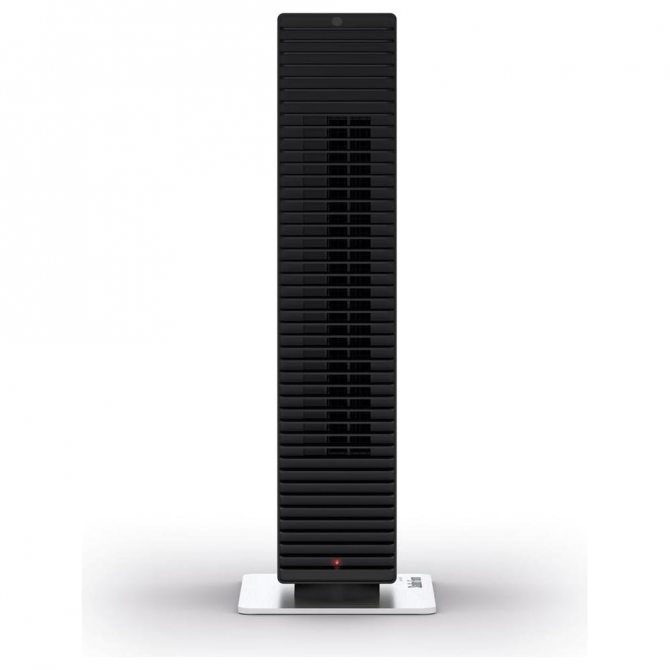

Fan heater with ceramic heater using "adaptive heat" technology. This technology is activated when using the device in automatic mode. Intelligent technology independently optimizes the power required to reach the desired temperature. The established microclimate indicators are maintained automatically.
In summer, the device can be used as a fan.Swing technology helps to distribute cool air masses in the room. The pressure with which the air flow is supplied is also adjustable. There are 8 different levels in total. If we compare with other models, then there are only 2 such modes.
With swing technology, the fan heater casing rotates for better air distribution.
The "auto-parking" function returns the device to its original position after turning it off.
The use of “adaptive heat” technology makes the device very quiet. Once the desired microclimate values have been achieved, the appliance maintains a cozy warmth, while emitting minimal noise.
All of these benefits have been noted by users in their reviews. Among the main advantages are efficiency and low noise level. There are no downsides.
The best ceramic fan heaters
REDMOND RFH-C4512
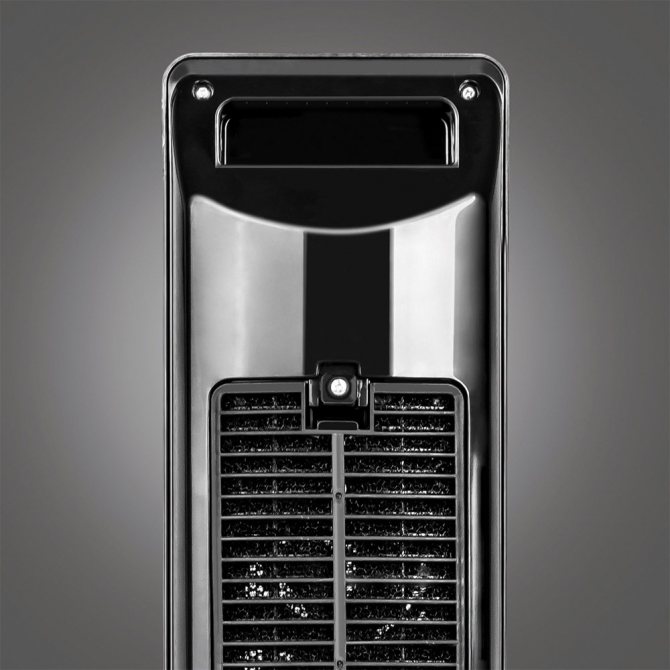

An innovative home appliance, efficient and almost silent. The device is distinguished by its fashionable design and reliability. There is a backlight and a control panel. The heater has 2 operating modes. The ceramic heating element is very robust and has a long service life.
The device does not dry the air, which is especially important in winter, providing an excellent microclimate. The fan heater turns off automatically when tilted or dropped. Additional functionality of the device includes:
- overheating protection;
- "Smart" system for maintaining the required temperature regime;
- removable dust filter;
- timer;
- touch-type control panel.
Benefits:
- low cost;
- convenient settings;
- overheating and falling protection;
- compactness combined with a large heating area;
- interesting design;
- minimal noise during operation;
- environmental safety (the device does not dry out the air);
- profitability.
Minus: the smell of plastic during work. It was also noted that the device is afraid of dampness, it is impossible to install it in the bathroom.
VITEK VT-2130
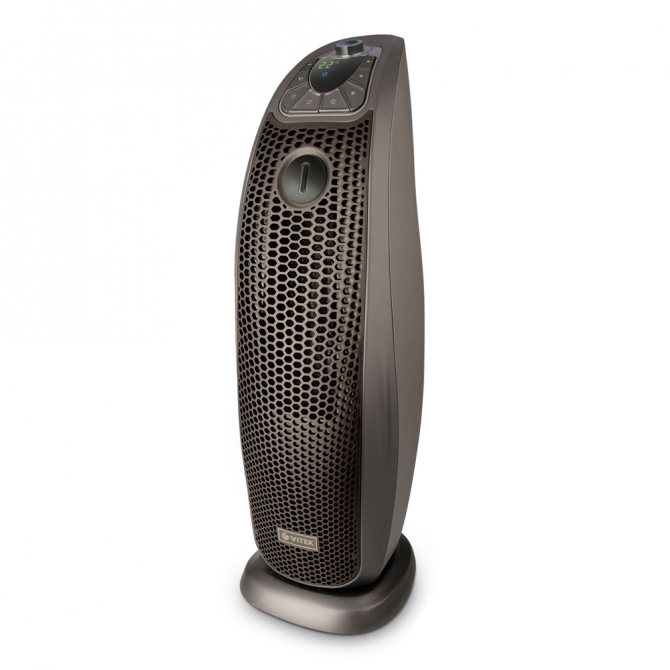

A multifunctional device with which you can not only heat a room up to 25 m2, but also effectively ventilate it. This is the perfect tool that comes in handy both in the summer heat and in the off-season. The device can also be used as a humidifier.
Thanks to special systems, it is very convenient and safe to use the fan heater. Electronic control - simple and intuitive. It is located at the top of the case, near a small display. There are 2 operating modes: 1800 and 900 W. The built-in intelligent system automatically turns on the device when the room temperature drops.
Benefits:
- modern "space" design;
- relatively low cost;
- rotating structure;
- compactness;
- almost complete absence of noise;
- ease of use;
- fast heating;
- humidification function.
Minus: the first few days of use, there is a slight "plastic" smell from the heating elements.
BORK O500
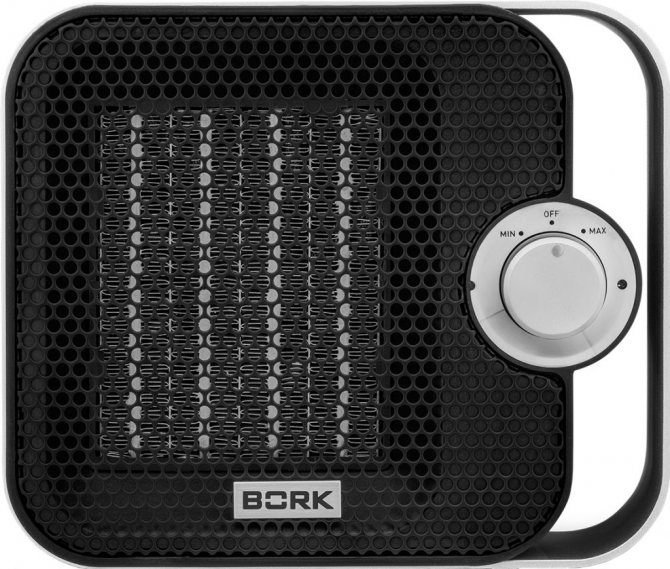

Compact ceramic heater of professional grade. The manufacturing company declared the area of the heated room to be 20-25 m2. The device emits a minimum of noise when used. The fan heater is equipped with a reliable security system.
When tilted more than 45 degrees, the device is automatically turned off. Heating element power 1200 W. There is also overheating protection. When the critical temperature is reached, the device turns off automatically.
Benefits:
- nice stylish design;
- reliability (2 years warranty);
- almost silent work;
- compactness;
- solid materials;
- fast enough heating;
- good assembly, without the slightest backlash;
- the presence of a filter.
Disadvantage: lack of a thermostat in the design. It was also noted that the effect of heating even a small room could be more noticeable. Most of the users are unanimous that this option is ideal for an office space, but not for home use.
Recommendations for using the device
Before buying a fan heater, you should read the tips for using fan heaters.
A list of useful knowledge is given below.
- If you need to warm your feet in the office, a cheap 1-1.5 kW heater with a spiral heater will do.
- Heaters for permanent use should be equipped with an automatic shut-off device in case of overheating or overturning. A thermostat is also desirable.
- To heat several rooms, a fan heater is required in each room.
- The appliance must not be placed on blankets, pillows or other surfaces that prevent cooling.
- It is forbidden to use conventional fan heaters in shower rooms and rooms with high humidity.
- Do not direct warm air onto plastic interior items.
Compliance with these recommendations will save money, keep the equipment working and prevent possible accidents.

